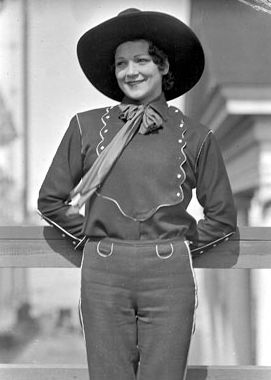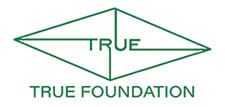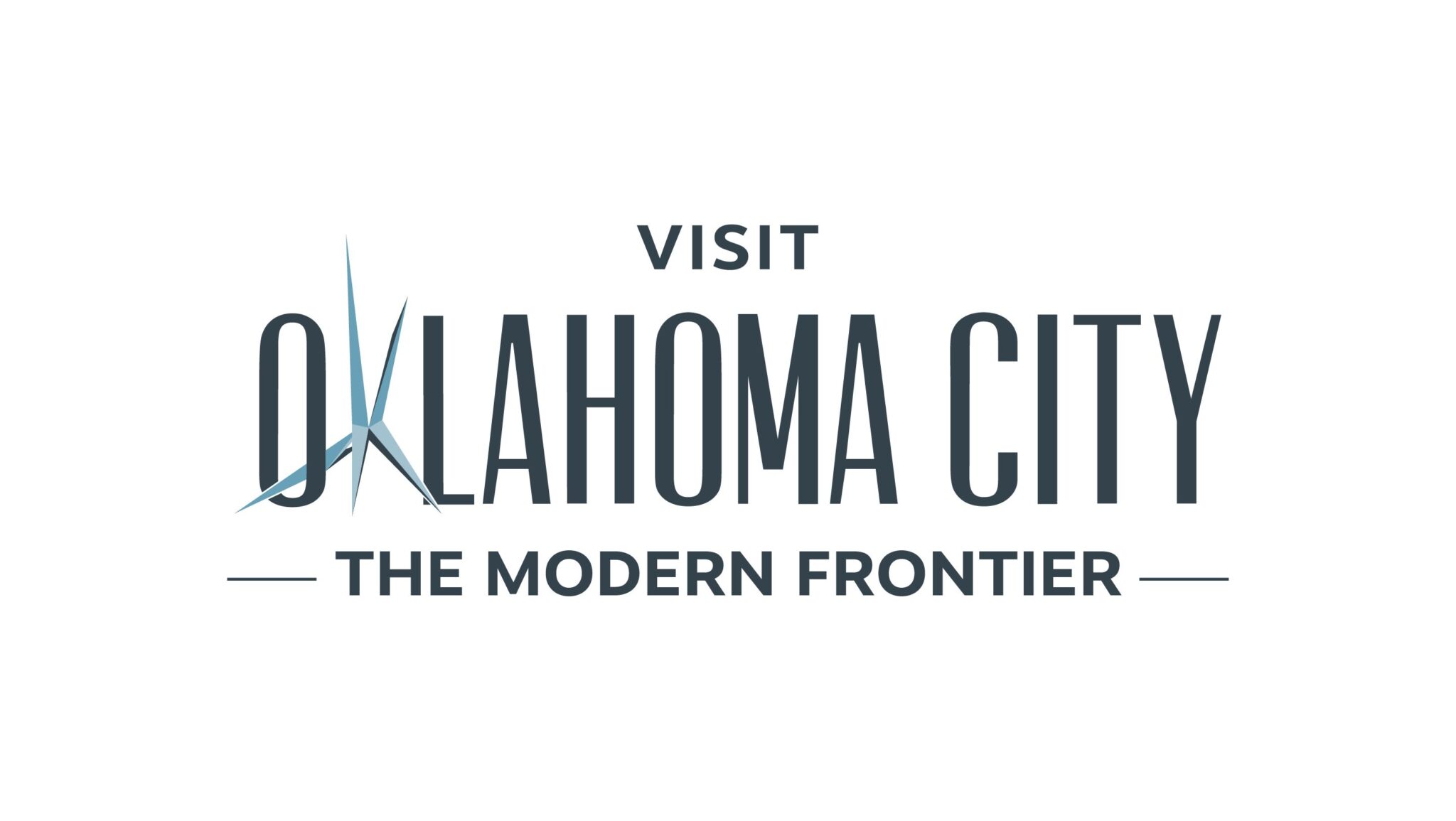
Lucyle Garmes Richards posed atop white horse
In the 1930s Lucyle Richards (Roberts) was generally considered the most beautiful of all the professional cowgirls. Married at one time to Oklahoma Curly Roberts, Richards became a rodeo star in Col. W. T. Johnson’s 1929 Dallas Rodeo in trick and bronc riding and in 1930 won the World Champion Saddle Bronc riding competition in Chicago. She won the bronc riding and all-around titles at Boston in 1934 and competed also in that year in Tex Austin’s London rodeo. Later, she participated with Alice Greenough and Pauline Nesbitt in the Wild Australian Stampede in Melbourne. Her life was not without scandal and controversy. In 1941 Richards was arrested and charged with the murder of her intended fourth husband, Frank Y. Dew. Apparently believing her story of shooting him in self-defense, the jury found her not guilty of first-degree murder charges after 21 hours of deliberation. During the 1940s and 1950s, Richards competed in saddle bronc riding sponsored by the Girls Rodeo Association (GRA) which was formed in 1948 and which is today called the WPRA (Women’s Professional Rodeo Association). She won her last championship at age 42 winning the GRA saddle bronc title in 1951. Retiring in 1960 she became a policewoman in Yokum, Texas in 1962. In 1987 she was inducted into the National Cowgirl Hall of Fame.

Mary Keen
Mary Keen was a bronc rider whose contemporaries were Vivian White, Lucyle Richards, Estelle Clark, Vaughn Krieg, Gene Creed, Margie and Alice Greenough.
In 1937 Alice Greenough responded to the advisement for women to avoid “vigorous sport” because they would likely damage their reproductive organs. In part she said, “A cow-woman takes no coddling, gets no martyr complex just because she is going to have a baby. She rides in the show up until two months before she expects the child–and she is back in the saddle bronc-riding in contests not later than six weeks afterward. This is the reward of developing strong backs, erect posture, educated muscles…Women with curved spines and swayed abdomens, with half the muscles in their bodies wasted from lack of exercise and use, who fear childbirth because they have not kept their bodies natural, wonder why their lives are not rich, full, vital–yet they never dream that the violation of natural health laws is the cause of everything.”

“Lorena Trickey”
Born in Palmer, Oregon, Lorena Trickey (1893-1961), a bronc, Roman, and relay rider captured the McAlpin Trophy in 1920, 1921, and 1924, which went to the champion all-around cowgirl at Cheyenne Frontier Days. In 1925 she won the bronc riding title at Chicago and several championships at Pendleton. She doubled for Mary Pickford in the movie “Through the Back Door” and worked with Tom Mix in “The Queen of Sheba.” Accused of stabbing to death her common-law husband, J. P. “Smiling Slim” Harris, during an argument, Trickey pleaded self-defense and was found not guilty in 1927. She married Magnus “Pete” Peterson in 1928 and the following year they retired from rodeo. Trickey died in 1961 and in 2000 she was inducted into the National Cowboy Hall of Fame’s Rodeo Hall of Fame.

“Donna Glover”
At the 1923 Yankee Stadium Rodeo in New York, Donna Card Glover won the relay racing contest. The most difficult and perhaps the most dangerous of all cowgirl contests, the relay race required riders to make three laps of the track, changing horses at the end of the first and second laps. Typically, the track is 1 ½ miles with each rider to have three horses and two assistants, one to hold and one to catch. Riders had to touch ground with both feet in making horse changes. In the early years, riders were required to unsaddle each horse and saddle the next one during the changeovers.
Vera McGinnis (1892-1990) nearly died from injuries sustained from a trampling during a relay race in 1934. She suffered a broken neck, broken hip, collapsed lung, and 5 fractured vertebrae.
Reva Gray, one of the best relay riders, died in 1938 at Cheyenne as a result of her horse and that of Gladys Pattinson’s colliding during a race.

“Mable [sic] Strickland”
Mabel Strickland (1897-1976) told a New York reporter, “I know you think I’m a paradox, but I belong in the saddle for I’ve been there since I was three. I love the open, dogs, horses, guns, the trees, the flowers…Still I love dresses and everything that goes with them.”
Strickland maintained this balance of femininity with the rough athleticism that rodeo required. However, with the introduction of sponsor contests at the Stamford, Texas Cowboy Reunion in 1931 traditional cowgirl contests began to be moved out of the American rodeo mainstream according to Mary Lou LeCompte. Sponsor girls competed in contests such as riding around barrels set in figure eight or cloverleaf patterns, flag races, cutting contests, and roping.
In her Cowgirls of the Rodeo, LeCompte writes “Regardless of the skills involved, costume, pulchritude, and bloodline were much more important than athletic ability in determining the final winners of sponsor contests…The introduction of sponsor contests was a major setback to women, as they represented all of the things that female athletes had to overcome, such as the emphasis on beauty and attire instead of athletic skill and the concept that females are really props or decorations, not legitimate athletes.”

“Bonnie Gray Jumping ‘King Tut’ over Auto. Days of 76 Deadwood, S.D.”
Becoming famous as a contract entertainer who jumped her horse, King Tut, over automobiles, Bonnie Gray (1891-1988) came to be known as the “King Tut Cowgirl” as well as the foremost trick rider of her day. In 1922 Gray tied with Mabel Strickland as winner of the trick riding competition at Madison Square Garden where she won $350. With her horse at full gallop, Gray was one of the first cowgirls to ride under the horse’s belly. This “Going Under the Belly” trick originated with Montana Jack Ray in 1910 while he was in the Young Buffalo and Texas Ranger Wild West Show. As a movie stuntwoman, Gray doubled for most of the cowboy stars including Tim McCoy, Tom Mix, Hoot Gibson and Ken Maynard. In 1981 Gray was inducted into the National Cowgirl Hall of Fame.

“Buck Taylor’s Famous Cowgirl Band”
It is uncertain whether or not this is the same person for whom the band is named, but William Levi Taylor, known as Buck Taylor, produced a Wild West show in 1894. Taylor was known as King of the Cowboys in Buffalo Bill’s Wild West and in a series of dime novels claimed as the first stories with a cowboy hero. Taylor died in 1924.
Buffalo Bill’s Cowboy Band with William Sweeney as its conductor from 1887 to 1913 was comprised of 36 mounted musicians in gray shirts, slouched hats, and moccasins. The Band played concerts and provided musical background to all the events.
Western music, including cowboy songs, string band ballroom dance music, and some hillbilly music, gained a widespread popularity in the 1930s particularly through the movies and recordings of Gene Autry and Roy Rogers and radio broadcasts. During the 1940s and 1950s western and country forms of music merged and slowly became Country music.

“Bea Kirnan Trick Riding Triangle Ranch Rodeo”
Interested in preserving the traditions of the West, Thomas Loyd Burnett (1871-1938) produced his first rodeo in 1917. Acquiring the 26,000-acreTriangle Ranch in 1910, Burnett built an arena there and produced a 4-day rodeo in 1924. Usually employing eight trick riders and paying each of them a minimum of fifty dollars a performance, Burnett paid his contract performers better than most rodeos. Burnett was inducted into the National Cowboy Hall of Fame’s Hall of Great Westerners in 1978.
Kirnan is shown here doing a Crouch Stand from the Withers.

“Toots Griffith Trick Riding Omaha, Neb.”
One of the shortest cowgirls of her day, Toots Griffith performed trick riding with her husband and son in the early 1920s as the Griffith Trio. She appeared with Fox Hastings and Ruth Roach at Tex Austin’s Rodeo in Chicago in 1926. Griffith is shown here doing a Hippodrome Stand, which is usually a routine finisher.

“Mary Brossit Trick Roper & Charlston [sic] Dancer”
In his 1928 book entitled Roping: Trick and Fancy Rope Spinning, Chester Byers (1892-1945), probably the best known roper in the world, wrote “Spinning a rope is the science or sport of throwing a short rope in such a way that a portion of it is dilated into a loop. This loop rotates in front of the roper or is swung about the body in various stunts and tricks.”
One among several “Lady Fancy Ropers” of the Byers’ era, Elsie Janis encouraged ladies in an introductory chapter to Byers’ book to learn how to rope. She advised them not to wear a dress for which they had future plans or to begin practicing in the drawing room, unless it was someone else’s house.

Unidentified Cowgirl doing Russian Drag in the Saddle
Sometimes referred to as the Cossack, Suicide or Death Drag, the Russian drag, in terms of difficulty, is a 10-point trick compared to the 95-point Going Between the Hind Legs from Above trick. Before attempting this trick, the rider must depend completely upon his horse and tighten his cinch. The rider, with one foot in the strap loop, hangs head downward over the saddle with the free foot raised above. To return to the saddle the rider lowers her left leg first to the left side of the horse and then swings her body upward and catches the horn in her left hand. She pulls herself up to a sitting position. According to Frank E. Dean in his book The Complete Book of Trick and Fancy Riding “the reason for the extra gesture with the left leg is to eliminate the possibility of going completely over the horse into a real suicide drag on the other side.”

“Florence Randolph Lady Champion Trick Rider”
Early in her career known as Princess Mohawk, the diminutive Florence Hughes Fenton Randolph (1898-1971) was an outstanding trick and bronc rider. She stunt doubled in Hollywood films for famous actresses in scenes requiring horses jumping over obstacles or ditches. In 1925 she married Floyd Randolph, a Wild West showman and saddle shop owner. Here Randolph is shown doing the One-Foot Slick Saddle Stand, a trick with a 70-point degree of difficulty.

“Opal Woods Making Four Horse Catch, Vinita Rodeo”
Will Rogers (1879-1935) was one of the greatest trick and fancy ropers of his time. The 1925 silent movie, “The Roping Fool,” is a showcase of Rogers’ skills and abilities. In his vaudeville show Rogers used ropes that ranged from seven to 90 feet in length. During one show in which none of the tricks were working the way he wanted, he quipped, “Swinging a rope is all right, when your neck ain’t in it. Then it’s hell.”

Alice Sisty Jumping Car
In 1932 Alice Sisty was one of several riders, including Pauline Lorenz, Rose Davis, Alice Adams, and Ivadell Jacobs, who were employed by Clyde Miller. Sisty married Milt Hinkle, nicknamed “The South American Kid,” on horseback in the arena at New Haven, Connecticut. During the 1930s Sisty did trick riding on her horse, Chappo, and competed in the cowgirls’ bronc riding.

Mamie Francis atop Bobby the Steer
Known as the “Annie Oakley of the Last Frontier,” sharpshooter Mamie Francis was born Elba May Ghent about 1885 in Janesville, Wisconsin. Married to Herbert Skepper, a renowned Roman rider, Francis joined Pawnee Bill’s Wild West Show in 1901. She remained there until 1907 when she joined the 101 Ranch Show. Married to Wild West show promoter, California Frank Hafley, since 1909, Francis made over 626 jumps on her white high-diving horse between 1908 and 1914 in spite of her inability to swim. During this time as well Francis was teamed with Princess Wenona in a vaudeville-shooting act known as Wenona and Francis. In 1950 Francis died at the age of 65 in Fort Worth, Texas.
Billed by his owner, Monte H. Reger, as the “World’s Famous Educated High Jumping Longhorn Steer,” Bobby was promoted as the “first bovine ever trained to jump over an automobile.” Born in 1923 and known also as Bobcat Twister, Bobby had horns, which measured 8 feet 6 inches in length.

“Paula Doucet on ‘Hitler’ Memphis Fair”
As it had consequences for every aspect of American culture, World War II impacted the sport of rodeo. Cowboys, such as Fritz Truan (1940 All-Around World Champion Cowboy), enlisted or were drafted thereby reducing the numbers of contestants. By 1941, 28 percent of the regularly scheduled rodeos in the United States and Canada usually held in connection with fairs had been canceled. According to Kristine Fredriksson in her book American Rodeo a few years earlier, rodeos had been added to many fairs to boost attendance. In 1935 the Mid-South Fair in Memphis, Tennessee became one such fair.
The first recognized rodeo to occur in wartime was the National Western in Denver, held January 10-17, 1942. According to Fredriksson, it was the first time in this rodeo’s history that each of the fifteen performances opened with a grand entry in which 150 mounted cowboys and cowgirls participated.

“Pauline Nesbitt on ‘Village Vamp’ 11th Annual Rodeo, Del Rio, Tex.”
While visiting friends in Gonzales, Texas at the age of about 13 years, Pauline Nesbitt rode her first bronc and, later, became one of the best cowgirl bronc riders in the sport. She began her career as a trick rider at Burwell, Nebraska in 1927. Upon her marriage to Jimmy Nesbitt, rodeo clown and contestant, in 1929, she quit riding broncs and continued trick riding. In 1934 she participated in the Wild Australian Stampede at Melbourne with Alice Greenough. In 1937 and 1938 she won the trick riding contest in Fort Worth, Texas.

“Mary Parks on ‘Kansas City Grey'”
Born and raised on a ranch near Walsenburg, Colorado, Mary Williams Parks (1910-1997) broke horses with her mother. She performed with Col. Jim Eskew’s JE Ranch Rodeo, the last rodeo to abandon cowgirl bronc riders and the first to include women’s barrel racing. In 1948 she retired from bronc riding. Parks was honored as an inductee by the National Cowgirl Hall of Fame in 1979 and was the recipient of the Tad Lucas Memorial Award given by the National Cowboy Hall of Fame in 1991.

“Prairie Rose on ‘Miss Cheyenne’ Frontier Days”
Prairie Rose Henderson won the saddle bronc riding contest at the second annual Los Angeles Rodeo in 1913. In 1917 Prairie Rose won the bronc riding championship at Cheyenne, Wyoming and received a large silver buckle from the Union Pacific Railroad. Earlier in her career, she participated in a number of flat races. While most cowgirls designed and made their outfits, Henderson designed clothing that even her peers considered outrageous. On occasion, Henderson would wear cowboy boots, silk stockings, and knee-length bloomers beneath a skirt trimmed in ostrich feathers. It is believed that sometime in the 1930s Henderson left her ranch home in a blizzard, became lost, and perished. Apparently, she was identified only by the silver buckle associated with the remains.

“Pauline Nesbitt on ‘Two Step’ Tucson Rodeo”
According to Mary Lou LeCompte in her book Cowgirls of the Rodeo, cowgirls won money in an average of 18 rodeos a year during the 1920s. Between 1920 and 1928, approximately one-third of all rodeos included contests for women. The rodeos that held women’s competitions usually scheduled two such events, with an average total purse of $4,735 per rodeo. In 1925 the average prize per person was $658.

“Tad Lucas on ‘Juarez'”
Beginning her career as a bronc rider in 1922 at Belle Fourche, South Dakota, Barbara Inez “Tad” Barnes Lucas (1902-1990) achieved greater success as a trick rider, which she mastered at the 1924 London rodeo. Between 1926 and 1933 Lucas won four trick riding titles at Forth Worth, Texas. She won the trick riding titles in 1925 and 1927 and the relay races in 1930, 1931, and 1932 at Cheyenne Frontier Days. She won the trick riding titles at Philadelphia in 1926 and Boston in 1931. Between 1925 and 1929 Lucas won three trick riding titles, two relay titles, and two all-around titles at Chicago. Her greatest achievements were at Madison Square Garden where she won the 1925, 1926, and 1928 through 1932 trick riding titles and the 1926 and 1928 through 1932 all-around cowgirl titles. She did not win a major bronc riding title until 1940 at Cheyenne Frontier Days.
Lucas was inducted into the National Cowboy Hall of Fame’s Rodeo Hall of Fame in 1968, inducted into the National Cowgirl Hall of Fame in 1978 and honored by the Professional Rodeo Cowgirls Hall of Fame in 1979. In 1990 the Rodeo Historical Society at the National Cowboy Hall of Fame established a memorial award in Lucas’s name. The annual award recognizes an outstanding woman of rodeo who “demonstrates the Tad Lucas zeal with her inventive and creative spirit and her zest to promote western values.”

“Marga [sic] Greenough on ‘Buster’ Colo State Fair”
In 1929 Margie Greenough Henson and her sister, Alice, joined the King Brothers Wild West Rodeo and Hippodrome Racing Unit. The next year she married Heavy Henson, a bulldogger. Greenough retired from the arena in 1954. She was inducted into the National Cowgirl Hall of Fame in 1978 and the National Cowboy Hall of Fame’s Rodeo Hall of Fame in 1983.

Tad Lucas on “Hell Cat”
Barbara Inez “Tad” Barnes Lucas (1902-1990) competed longer than any other cowgirl and was not only a world champion trick rider and several-time all-around cowgirl, but also a leader and innovator in rodeo fashion. In 1924 Lucas wore leather chaps for bronc riding and later, she created the Mexican style suit comprised of colorful patches of cloth stitched into or along the seam of the flare of bell-bottomed slacks. Lucas is pictured here in white woolly chaps, a popular item with the cowgirls in the mid 1940s.

“Loretta Buttler [sic] in Steer Riding Contest”
According to statistics compiled and analyzed by Mary Lou LeCompte in her book Cowgirls of the Rodeo, of the 607 women who participated in professional rodeo between 1882 and 1955, only 47, (8%) contested in the steer riding event. During that period relay racing was the number one event in which women participated, 268 women or 44%.
Between 1920 and 1936 of the 265 women participating in rodeo, 38 women (14%) contested in the steer-riding event. Finally, between 1947 and 1955 of the 166 women participating in professional rodeo, only 7 women (4%) contested in steer riding. During this time, barrel racing had assumed the number one participatory event for women, 86 women or 52%.

“Peggy Murray Riding Wild Steer Compton-Hughes Rodeo”
According to Bob Jordan in his book Rodeo History and Legends, steer riding began when cowboys mounted steers as they were let up after being tied in the steer roping. With nothing to grab onto, they would ride a few jumps then jump off…much to the amusement of spectators. Tad Lucas made her professional debut riding a steer at the Gordon, Nebraska, Fair in 1917. By the late 1940s steer riding had nearly disappeared from rodeo competitions.

“Fox Hastings Bulldogging”
Although often credited as being the first woman bulldogger, Eloise “Fox” Hastings Wilson (1882-1948) was probably the fourth woman bulldogger (1924) behind Tillie Baldwin (1913), Blanche McGaughey (1914), and Anita Ingles (1922).

“Vaughn Kreig [sic] on ‘Boxer’ Colorado State Fair”
Born on a Colorado ranch in 1904, Vaughn learned to ride before she was five and helped her brothers break wild horses and chase stray cattle. By the age of eighteen Vaughn was married with two sons and lived on a farm near Mesa de Maya, Colorado. Joining the rodeo in 1926, she fulfilled trick riding obligations for her sister, Gene, who had suffered a ruptured appendix. She quickly became one of the top bronc riders. Krieg was the first woman to bulldog a steer from the running board of a moving automobile. After several failed marriages, Krieg married Lynn Huskey in 1933 and purchased a ranch near Towson, Oklahoma naming it the “Flying V.” At Madison Square Garden in 1934 Krieg won the bronc riding event and a prize of $615. Producing Flying V Rodeos since 1937, Krieg formed the Flying V All Cow-Girl Rodeo Company in 1942, which opened at the Lamar County Fair Grounds near Paris, Texas. One of the few women producers in rodeo history, Krieg died in 1976.

Mabel Strickland saddle bronc riding
Upon the death of Bonnie McCarroll, who was thrown from and trampled by a bronc in 1929 at the Pendleton RoundUp, the controversy over whether or not cowgirl bronc riding should or should not be included in rodeo programs was ignited. The Pendleton RoundUp committee dropped cowgirl bronc riding immediately after McCarroll’s death. Moreover, the newly created Rodeo Association of America (R.A.A.), the first organization that attempted to regulate and standardize rodeos, was opposed to cowgirl events. R.A.A. sanctioned rodeos, which never included more than 100 rodeos in its 17-year existence, had to include eight recognized contests sometimes at the expense of cowgirl contests and events.



























